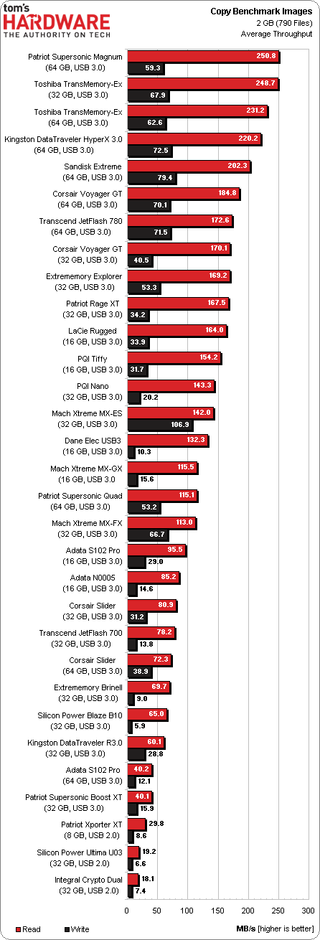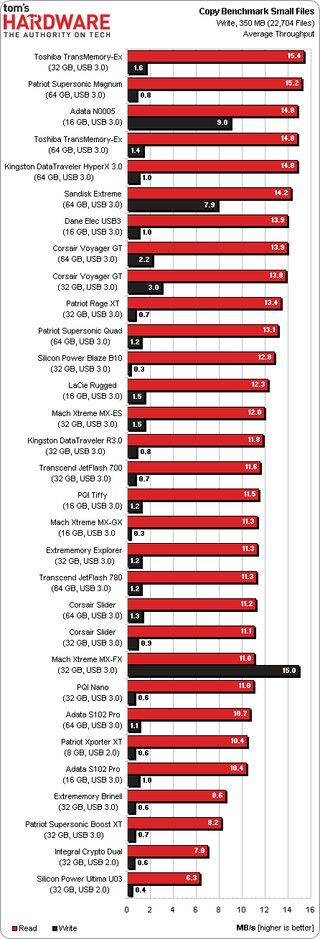31 USB 3.0 Thumb Drives, Tested And Reviewed
It's hard to believe that the fastest USB 3.0-rated thumb drives can outperform the hard drive in your desktop PC. On the other hand, the slowest models shouldn't even be allowed USB 3.0 branding. We test 31 different drives to determine the quickest.
Results: Copying Small Files
When we look at peak read and write performance using a synthetic benchmark, you already know that you'll rarely (if ever) see those numbers in the real world. Practically, you're more likely to load a thumb drive up with a handful of big files and a bunch of smaller ones. This negatively affects performance. Our copy benchmarks should give you a much better idea of how these drives will behave in practice.
Copying Pictures
Our first real-world test reads and writes 790 pictures with a combined size of 2 GB to and from the thumb drives. Interestingly, the finishing order is about the same for reading the pictures as it was for sequential read performance in CrystalDiskMark. Transfer rates are slower across the board, though.
The Patriot Supersonic Magnum wins this metric with a transfer rate of 250.8 MB/s. Four other drives also achieve speeds in excess of 200 MB/s: the Toshiba TransMemory-EX 32 GB, Toshiba's TransMemory-EX 64 GB, the Kingston DataTraveler HyperX 3.0, and SanDisk's Extreme. Only the drives in the lower third of the field read our picture files at less than 100 MB/s. Last place is almost a draw between Adata's S102 Pro 64 GB with 40.2 MB/s and the Patriot Supersonic Boost XT with 40.1 MB/s. Unfortunately, those numbers aren't much better than last generation's USB 2.0-compatible thumb drives.
The Mach Xtreme MX-ES writes our workload fastest, averaging 106.9 MB/s. It’s followed (though not very closely) by SanDisk's Extreme, which posts 79.4 MB/s.

Copying MP3s
The results for copying 356 MP3 files with a combined size of 2 GB are, perhaps not surprisingly, similar to those for copying pictures. The same five USB 3.0 thumb drives achieve speeds of more than 200 MB/s in our read test: the Patriot Supersonic Magnum, Toshiba's TransMemory-EX 32 GB, the Toshiba TransMemory-EX 64 GB, Kingston's DataTraveler HyperX 3.0, and the SanDisk Extreme.
Patriot's drive takes the crown in reads by averaging 259.5 MB/s. The Mach Xtreme MX-ES wins the writing benchmark once again by hitting 134.6 MB/s. This time, though, it’s followed closely by SanDisk's Extreme, which posts 122.2 MB/s. The Patriot Supersonic Magnum and the Transcend JetFlash 780, which share third place in this benchmark, are quite a bit slower at 82.0 MB/s.

Copying Many Small Files
There's not much left of these drives' impressive sequential write speed once we start sending a lot of really small files through them (22,704, with a combined size of 350 MB, to be exact).
A good thumb drive should at least maintain bearable performance under these conditions, and three of the products in our round-up do get there: the Mach Xtreme MX-FX, which actually writes faster (at 15.0 MB/s) than it reads (11 MB/s), Adata's N0005 at 9.0 MB/s, and the SanDisk Extreme, achieving an acceptable 7.9 MB/s.

Current page: Results: Copying Small Files
Prev Page Results: 512 KB Random Read And Write Performance Next Page Results: AS SSD Copy BenchmarkStay on the Cutting Edge
Join the experts who read Tom's Hardware for the inside track on enthusiast PC tech news — and have for over 25 years. We'll send breaking news and in-depth reviews of CPUs, GPUs, AI, maker hardware and more straight to your inbox.
-
psikick It's not a surprise the Sandisk wins because this USB drive is actually a small SSD.. It uses the same controller used in Sandisk's ReadyCache SSD drives... the great thing about it is it is priced reasonably considering.. :)Reply -
Madn3ss795 Been using this usb3.0 *SSD from Sandisk for half a year and I haven't got disappointed.Great device for the price. The only drawback I found is that its enclosure gets quite hot after 15mins of heavy use ( benchmarking ) because heat might reduce a SSD' durability.Reply -
razor512 The sandisk extreme works well.Reply
I currently have the 16GB version (was $20 when I got it)
http://www.flickr.com/photos/razor512/8272978749/does 200MB/s read and 57.3MB/s write
not as good as the the 64GB version but it is still really good
Read speed: http://i.imgur.com/TdcufSg.png
Write speed: http://i.imgur.com/jQVkBCa.png -
daveys93 I have the 32 GB version of the SanDisk Extreme and it is a great thumb drive. The 16 GB version is a bit slow and the 64 GB is a bit expensive for some, the 32 GB is a good middle ground. Here are the benchmarks I used when trying to decide which USB3.0 drive to get:Reply
http://www.whoratesit.com/SanDisk-Extreme-USB-30-32GB/Rating/1466
There is a toggle on that site that allows you to view the benchmark results for all three sizes.
Here is the full whoratesit.com article as a complement to the Toms article: http://www.whoratesit.com/Best-Flash-Drive/Comparison/1#rank1 -
WyomingKnott In my case the limiting factor is the controller / port. I've got three USB 3.0 controllers: On my notebook at work, built into the motherboard at home, and a PCI-E one. The PCI-E one is twice the speed of the lowest one in 4k random writes.Reply
If I were home I'd post the controller and the thumb drive model, but I'm not there so don't ask. -
aznriptide859 Why no Corsair Flash Survivor? :( I love mine, albeit the write times aren't the speediest.Reply -
RedJaron Reply11204798 said:In my case the limiting factor is the controller / port. I've got three USB 3.0 controllers: On my notebook at work, built into the motherboard at home, and a PCI-E one. The PCI-E one is twice the speed of the lowest one in 4k random writes.
If I were home I'd post the controller and the thumb drive model, but I'm not there so don't ask.
Too true, don't forget the controller speed. The Etron controller in my old-ish Z68 board ensures my USB 3.0 devices rarely go above 25 MBps even though I can get double that performance on my newer work computer.
